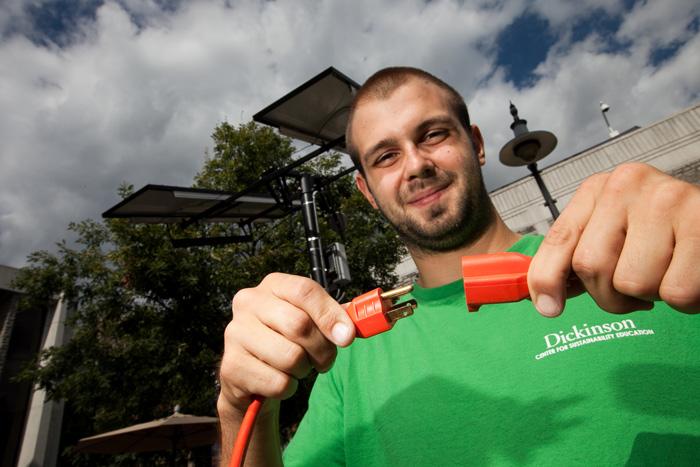(More) Power to the People

Photo by Carl Socolow '77.
Solar Outdoor Laboratory keeps Britton Plaza plugged in
by Tony Moore
So there was Justin McCarty ’15, rummaging through a campus warehouse during summer 2013, looking for furniture for the Dog House. In with the stacks of chairs and desks and whiteboards stood four solar panels.
If you know McCarty, an environmental studies and economics double major, you know that finding these panels collecting dust in a warehouse was just the kind of thing to get his mental gears turning. Asking around, he found that the panels were left over from the Treehouse (Center for Sustainable Living) construction and had been set aside for “educational purposes.”
As he saw it, what could be more educational than setting up a solar array on one of the busiest spots on campus—in front of the Holland Union Building (HUB)—to raise awareness for alternative energy and electricity generation?
“We could have just put the panels up on the HUB’s roof,” McCarty says, “but we wanted to stick with an educational theme: The array puts the idea of electricity generation—which is not something a lot of people think about—right here, so people can interact with it daily.”
By this summer, McCarty’s vision was a reality, and Britton Plaza was full of students, many from the Idea Fund, digging trenches to run cable and erecting the array’s support pole. They also helped install a new electrical outlet on the Waidner-Spahr Library side of the plaza, which helps double electrical access for plaza dwellers and events.
McCarty himself helped install the panels, finishing off what would become known as the Solar Outdoor Laboratory (SOL), the newest extension of the college’s ongoing “living laboratory.”
“At Dickinson, we have opportunities to experience things that students normally wouldn’t get to experience, so why not give them another one?” he says, noting that the SOL, like other living-laboratory elements on campus such as the College Farm and ALLARM [Alliance for Aquatic Resource Monitoring], encourages hands-on learning. “It’s about finding a way to experience something in the practical sense, beyond the theoretical.”
Funded by Student Senate and the Idea Fund, the SOL will be up and running on Oct. 18, at which point it will start generating electricity to sell back to the grid. But McCarty hopes that its main draw is as an educational tool—one helped in its mission by a sign explaining solar power, the SOL itself and the idea of the living laboratory—that informs passersby in the midst of their daily routine.
Learn more
- Student Snapshot: "Justin McCarty: Recycle, Rebuild, Renew"
- Sustainability at Dickinson
- Latest News
Published October 16, 2014